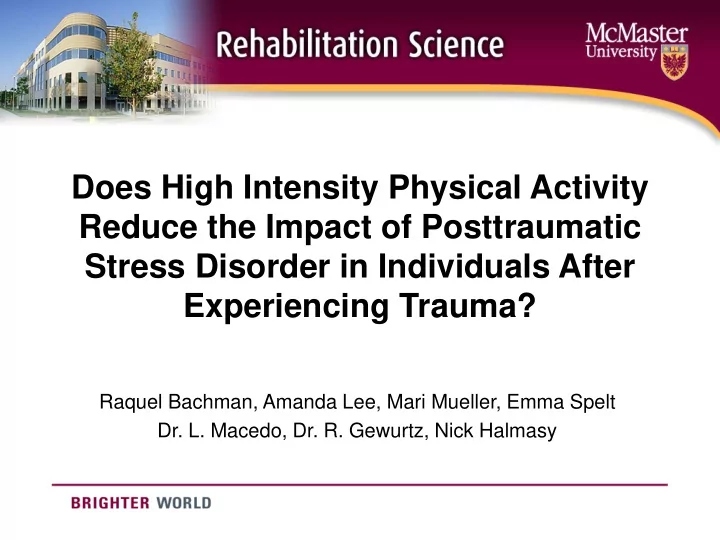

Does High Intensity Physical Activity Reduce the Impact of Posttraumatic Stress Disorder in Individuals After Experiencing Trauma? Raquel Bachman, Amanda Lee, Mari Mueller, Emma Spelt Dr. L. Macedo, Dr. R. Gewurtz, Nick Halmasy
Introduction • Collaborative project between OT and PT • OT students: qualitative research with firefighters • Our group: scoping review on HIPA and PTSD • Unable to identify research on first responders • Expanded population to all individuals with PTSD
Introduction • PTSD is prevalent in first responders • 10-22% in paramedics, police, firefighters • Currently: stigma receiving treatment • Less stigma with exercise?
Introduction • Post-Traumatic Stress Disorder (PTSD) – Caused by exposure to a traumatic event – Duration >1 month – Symptoms: re-experiencing, avoidance, negative affect, hyperarousal, sense of imminent threat • High-Intensity Physical Activity (HIPA) – Maximum heart rate 70-85% or 6 METs – Examples: running, plyometrics, resistance training
Purpose and Objectives • Purpose: examine the literature on HIPA for PTSD, with a focus on first responders • Primary question: ‘Does high intensity physical activity reduce the impact of PTSD in individuals after experiencing trauma ?’
Methods • Databases: MEDLINE, PsychINFO, EMBASE, CINAHL • Study designs: RCTs, quasi-experimental designs, cohort studies, case-controlled studies, longitudinal cohort studies • Population: those who experienced an emotional trauma
Methods • Data collection: worked in pairs to review titles and abstracts, perform full text screening, retrieve articles, and extract data from studies • Risk of bias assessment: Critical Review Form for Quantitative Studies (Law et al.)
Results • Initial search: no studies on HIPA and PTSD in first responders identified • Broader search: 5,274 articles • Title and abstract screening: 52 articles • 48 articles retrieved – 4 articles: authors emailed with no reply • 11 articles included
Results: Study Characteristics • Study Designs • Participants – 5 pre-post test – 2 studies: children – 4 RCT – 3 studies: veterans – 2 prospective cohort – 8 studies: community • Sample Sizes • Locations – 8 studies; < 50 subjects – All developed countries – 2 studies; > 100 subjects – 8 US, 2 Canada, 1 Aus
Results: Characteristics of Exercise Study Types: – 4 aerobic exercise • Walking, running on treadmill; biking • 20-40 min bouts – 2 group-based • Plyometrics – 2 combined: aerobic + resistance – 2 self-report – 1 surfing intervention
Results: Outcome Measures • PTSD Checklist-Civilian Version • PTSD Checklist-Military Version • Children PTSD inventory • Depression Anxiety and Stress Scale (DASS) • Beck Depression Inventory • Beck Anxiety Inventory • State-Trait Anxiety Inventory
Results: HIPA outcomes RCTs – Fetzner et al (2015): no between group differences for PTSD symptoms between attentions to somatic arousal, distraction from somatic arousal, and exercise with no distractions (1 month follow up) – Powers et al (2015): PE + exercise had greater effects on BDNF than PE alone (3 month follow up) – Rosenbaum et al (2015) : resistance training greater improvements in PTSD symptoms vs. usual care (immediately post-intervention) – LeBouthiller et al (2017) : improvements in PTSD in aerobic and resistance group vs. waitlist (1 week follow up)
Results: HIPA Outcomes Longitudinal Cohort – Whitworth et al (2017): self-report vigorous activity associated with decreased PTSD symptoms (3 month follow-up) – Leardmann et al (2011): self-report vigorous physical activity associated with decreased PTSD symptoms vs. moderate and light (3 year follow-up)
Results: HIPA Outcomes • Pre-post (within group differences) – Newman et al (2007): group plyometric exercise associated with significant in PTSD in children (1 month follow-up) – Manger et al (2005): supervised group aerobic exercise associated with decreased PTSD (1 month follow-up) – Diaz et al (2008): aerobic exercise associated with reductions in PTSD (1 month follow-up) – Rogers et al (2014): improvements in PTSD after 5 weeks of surfing (immediately post-intervention)
Discussion • Large heterogeneity in studies • Overall HIPA associated with decreased prevalence of PTSD symptoms from baseline • Studies found improvements in PTSD symptoms using both high intensity aerobic + resistance training – Compared to: usual care, waitlist, exercise with somatic arousal, prolonged exposure therapy
Limitations • No clear definition of HIPA in literature • Lack of clear definition of exercise intensity – could not include these studies • Heterogeneity of studies • Risk of Bias tool
Clinical Relevance • Limited evidence that HIPA may positively impact those diagnosed with PTSD • Possible alternative for PTSD management – May reduce stigma
Future Directions • Establish parameters and guidelines • Is one type of exercise superior to another? • HIPA for PTSD in first responders • Optimal time to implement exercise (primary or secondary prevention)? • Feasibility in first responders?
Conclusion • Literature limited in first responders • Results of scoping review: low quality evidence that HIPA may have beneficial effect on PTSD • Many unknowns and need for future research
Acknowledgments We express our gratitude for the help and guidance from our supervisor Dr. Luciana Macedo. We would also like to thank Dr. Rebecca Gewurtz and Nick Halmasy for their collaboration.
Questions
Recommend
More recommend